Abstract
Types A and B Niemann-Pick disease (NPD) result from inherited deficiencies of the lysosomal hydrolase, acid sphingomyelinase (ASM; sphingomyelin cholinephosphohydrolase, EC 3.1.4.12). To evaluate the feasibility of somatic gene therapy for the treatment of these disorders, retroviral-mediated gene transfer was used to introduce the full-length ASM cDNA into cultured fibroblasts from two unrelated type A NPD patients. The ASM activities in these cells were less than 4% of mean normal levels, and, consequently, they accumulated approximately 3-fold elevated levels of sphingomyelin. After retroviral-mediated transfer of the ASM cDNA, ASM activities in the NPD cells increased to levels up to 16-fold those found in normal fibroblasts. In addition, the sphingomyelin content was reduced to normal levels, indicating that the vector-encoded enzyme was properly targeted to lysosomes, where it was enzymatically active and able to degrade the accumulated substrate. In situ cell-loading studies also were undertaken to evaluate the effects of retroviral-mediated gene transfer on the pathology of NPD fibroblasts. When a pyrene derivative of sphingomyelin was introduced into the lysosomes of cultured fibroblasts from a type A NPD patient by using apolipoprotein E-mediated endocytosis, only approximately 6% of the delivered substrate was degraded. In contrast, normal cells and NPD cells transduced (i.e., "corrected") by retroviral-mediated gene transfer could degrade approximately 80% of the delivered sphingomyelin. These results provided further evidence that retroviral-mediated gene transfer may be used to correct the pathology of NPD cells. Cell-loading studies were also used to develop a selection system for discriminating between NPD cells and those transduced by retroviral-mediated gene transfer. This selection scheme was based on the fluorescence emission of intact NPD cells, which, when loaded with pyrene-labeled sphingomyelin, was 3- to 5-fold that of normal or transduced cells. As a consequence, the NPD and transduced cells could be efficiently sorted by flow cytometry with a fluorescence-activated cell sorter. In addition, the NPD cells could be selectively killed by photosensitization after irradiation with a long-wavelength UV light. These results should permit direct selection of ASM-expressing cells after retroviral-mediated gene transfer without the need to preselect for a cotransferred marker gene.
Full text
PDF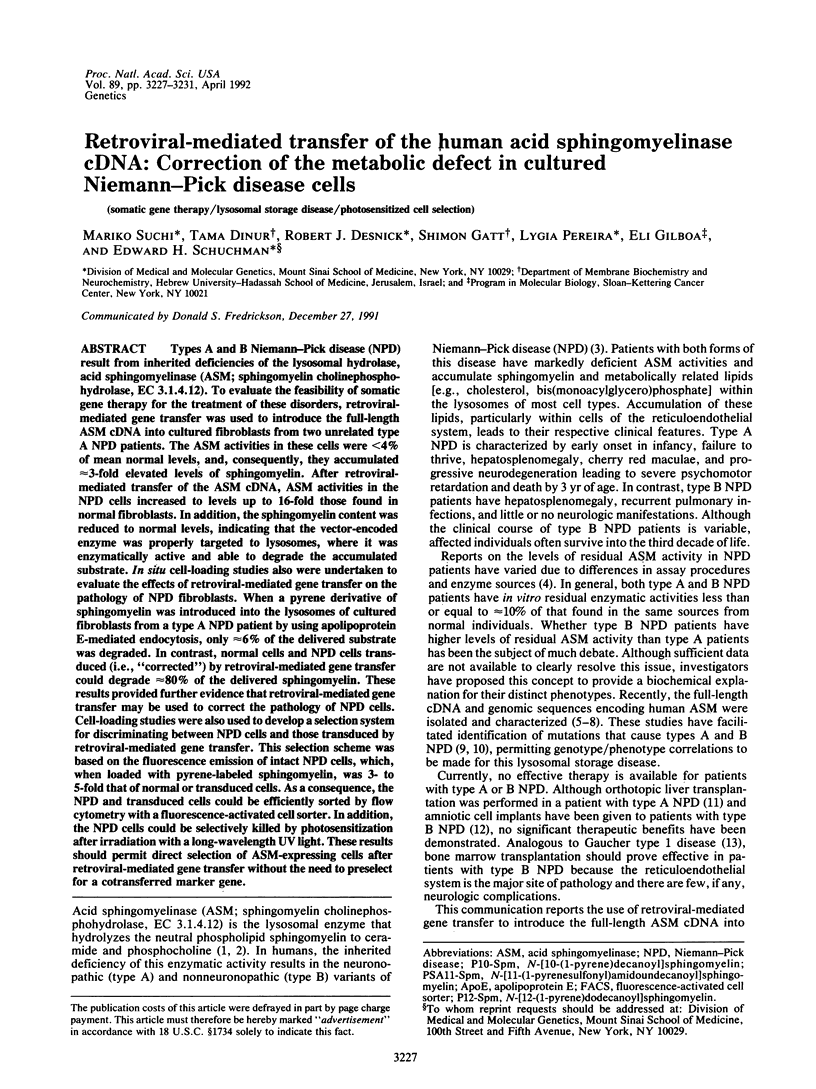
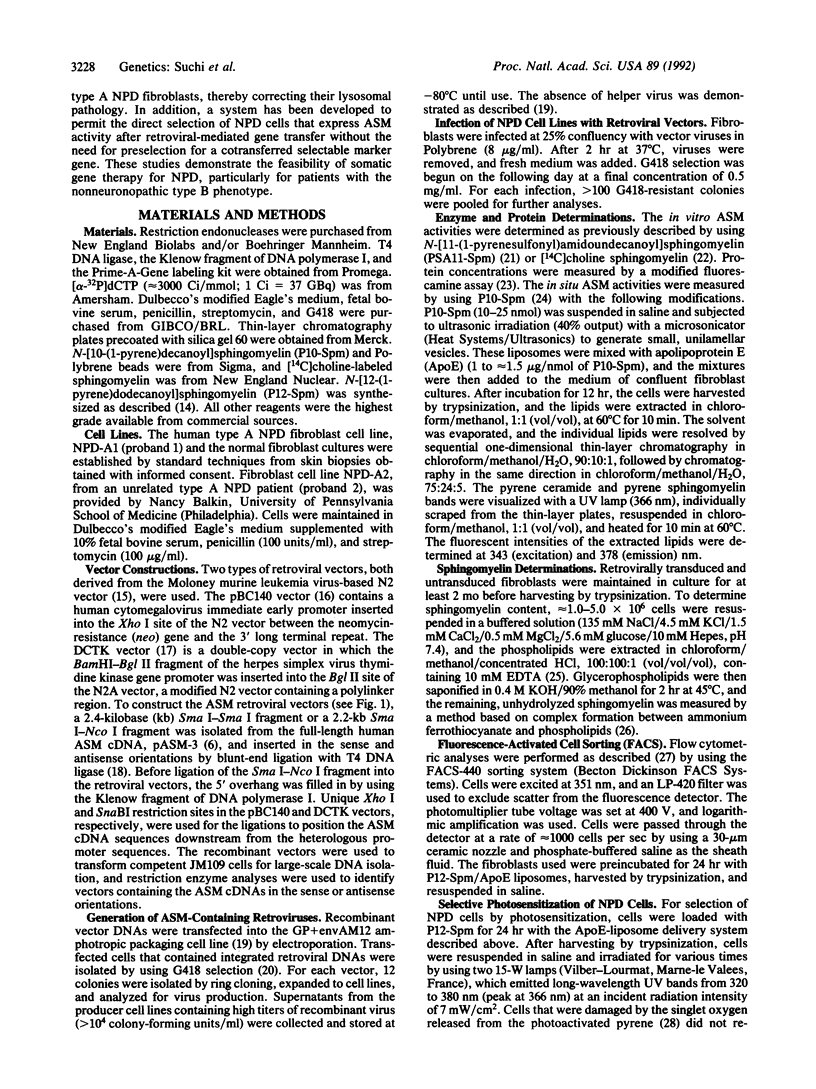
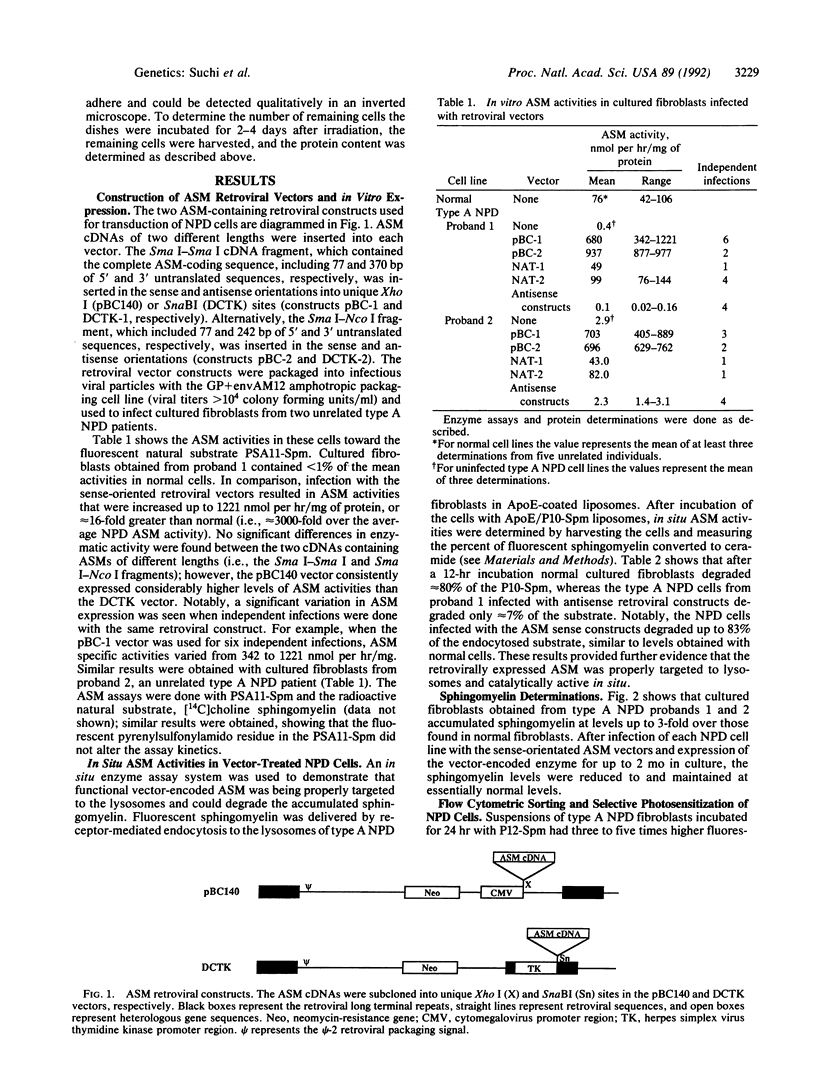
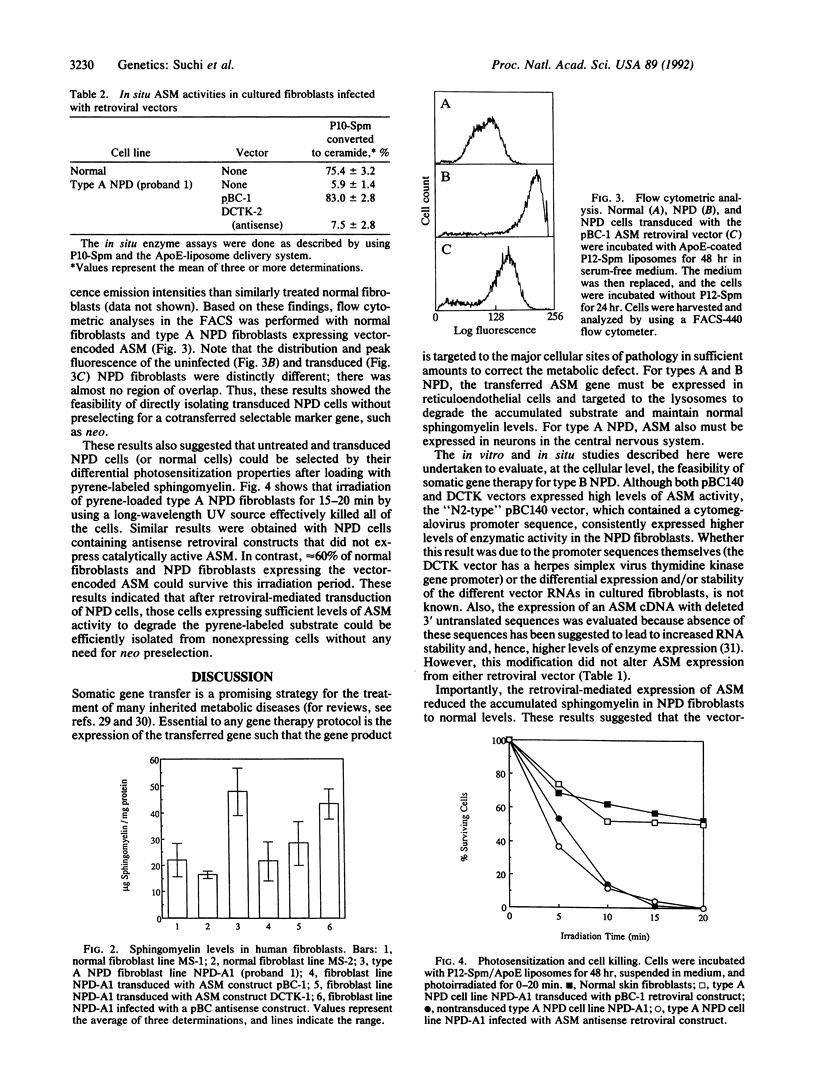
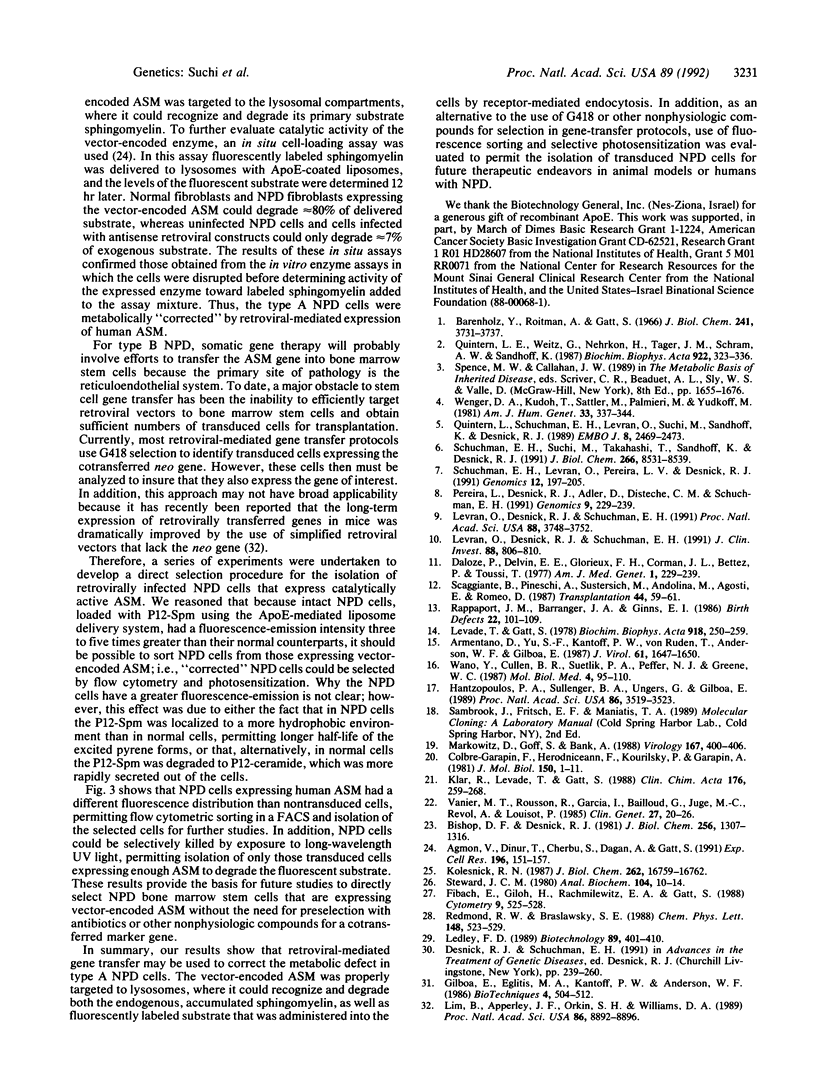
Selected References
These references are in PubMed. This may not be the complete list of references from this article.
- Agmon V., Dinur T., Cherbu S., Dagan A., Gatt S. Administration of pyrene lipids by receptor-mediated endocytosis and their degradation in skin fibroblasts. Exp Cell Res. 1991 Oct;196(2):151–157. doi: 10.1016/0014-4827(91)90244-o. [DOI] [PubMed] [Google Scholar]
- Armentano D., Yu S. F., Kantoff P. W., von Ruden T., Anderson W. F., Gilboa E. Effect of internal viral sequences on the utility of retroviral vectors. J Virol. 1987 May;61(5):1647–1650. doi: 10.1128/jvi.61.5.1647-1650.1987. [DOI] [PMC free article] [PubMed] [Google Scholar]
- Barnholz Y., Roitman A., Gatt S. Enzymatic hydrolysis of sphingolipids. II. Hydrolysis of sphingomyelin by an enzyme from rat brain. J Biol Chem. 1966 Aug 25;241(16):3731–3737. [PubMed] [Google Scholar]
- Bishop D. F., Desnick R. J. Affinity purification of alpha-galactosidase A from human spleen, placenta, and plasma with elimination of pyrogen contamination. Properties of the purified splenic enzyme compared to other forms. J Biol Chem. 1981 Feb 10;256(3):1307–1316. [PubMed] [Google Scholar]
- Colbère-Garapin F., Horodniceanu F., Kourilsky P., Garapin A. C. A new dominant hybrid selective marker for higher eukaryotic cells. J Mol Biol. 1981 Jul 25;150(1):1–14. doi: 10.1016/0022-2836(81)90321-1. [DOI] [PubMed] [Google Scholar]
- Daloze P., Delvin E. E., Glorieux F. H., Corman J. L., Bettez P., Toussi T. Replacement therapy for inherited enzyme deficiency: liver orthotopic transplantation in Niemann-Pick disease type A. Am J Med Genet. 1977;1(2):229–239. doi: 10.1002/ajmg.1320010209. [DOI] [PubMed] [Google Scholar]
- Fibach E., Giloh H., Rachmilewitz E. A., Gatt S. Flow cytofluorometric analysis of the uptake of the fluorescent fatty acid pyrene-dodecanoic acid by human peripheral blood cells. Cytometry. 1988 Nov;9(6):525–528. doi: 10.1002/cyto.990090603. [DOI] [PubMed] [Google Scholar]
- Hantzopoulos P. A., Sullenger B. A., Ungers G., Gilboa E. Improved gene expression upon transfer of the adenosine deaminase minigene outside the transcriptional unit of a retroviral vector. Proc Natl Acad Sci U S A. 1989 May;86(10):3519–3523. doi: 10.1073/pnas.86.10.3519. [DOI] [PMC free article] [PubMed] [Google Scholar]
- Klar R., Levade T., Gatt S. Synthesis of pyrenesulfonylamido-sphingomyelin and its use as substrate for determining sphingomyelinase activity and diagnosing Niemann-Pick disease. Clin Chim Acta. 1988 Sep 15;176(3):259–267. doi: 10.1016/0009-8981(88)90185-4. [DOI] [PubMed] [Google Scholar]
- Kolesnick R. N. 1,2-Diacylglycerols but not phorbol esters stimulate sphingomyelin hydrolysis in GH3 pituitary cells. J Biol Chem. 1987 Dec 15;262(35):16759–16762. [PubMed] [Google Scholar]
- Levade T., Gatt S. Uptake and intracellular degradation of fluorescent sphingomyelin by fibroblasts from normal individuals and a patient with Niemann-Pick disease. Biochim Biophys Acta. 1987 Apr 24;918(3):250–259. doi: 10.1016/0005-2760(87)90228-1. [DOI] [PubMed] [Google Scholar]
- Levran O., Desnick R. J., Schuchman E. H. Niemann-Pick disease: a frequent missense mutation in the acid sphingomyelinase gene of Ashkenazi Jewish type A and B patients. Proc Natl Acad Sci U S A. 1991 May 1;88(9):3748–3752. doi: 10.1073/pnas.88.9.3748. [DOI] [PMC free article] [PubMed] [Google Scholar]
- Levran O., Desnick R. J., Schuchman E. H. Niemann-Pick type B disease. Identification of a single codon deletion in the acid sphingomyelinase gene and genotype/phenotype correlations in type A and B patients. J Clin Invest. 1991 Sep;88(3):806–810. doi: 10.1172/JCI115380. [DOI] [PMC free article] [PubMed] [Google Scholar]
- Lim B., Apperley J. F., Orkin S. H., Williams D. A. Long-term expression of human adenosine deaminase in mice transplanted with retrovirus-infected hematopoietic stem cells. Proc Natl Acad Sci U S A. 1989 Nov;86(22):8892–8896. doi: 10.1073/pnas.86.22.8892. [DOI] [PMC free article] [PubMed] [Google Scholar]
- Markowitz D., Goff S., Bank A. Construction and use of a safe and efficient amphotropic packaging cell line. Virology. 1988 Dec;167(2):400–406. [PubMed] [Google Scholar]
- Quintern L. E., Schuchman E. H., Levran O., Suchi M., Ferlinz K., Reinke H., Sandhoff K., Desnick R. J. Isolation of cDNA clones encoding human acid sphingomyelinase: occurrence of alternatively processed transcripts. EMBO J. 1989 Sep;8(9):2469–2473. doi: 10.1002/j.1460-2075.1989.tb08382.x. [DOI] [PMC free article] [PubMed] [Google Scholar]
- Quintern L. E., Weitz G., Nehrkorn H., Tager J. M., Schram A. W., Sandhoff K. Acid sphingomyelinase from human urine: purification and characterization. Biochim Biophys Acta. 1987 Dec 14;922(3):323–336. doi: 10.1016/0005-2760(87)90055-5. [DOI] [PubMed] [Google Scholar]
- Rappeport J. M., Barranger J. A., Ginns E. I. Bone marrow transplantation in Gaucher disease. Birth Defects Orig Artic Ser. 1986;22(1):101–109. [PubMed] [Google Scholar]
- Scaggiante B., Pineschi A., Sustersich M., Andolina M., Agosti E., Romeo D. Successful therapy of Niemann-Pick disease by implantation of human amniotic membrane. Transplantation. 1987 Jul;44(1):59–61. doi: 10.1097/00007890-198707000-00014. [DOI] [PubMed] [Google Scholar]
- Schuchman E. H., Levran O., Pereira L. V., Desnick R. J. Structural organization and complete nucleotide sequence of the gene encoding human acid sphingomyelinase (SMPD1). Genomics. 1992 Feb;12(2):197–205. doi: 10.1016/0888-7543(92)90366-z. [DOI] [PubMed] [Google Scholar]
- Schuchman E. H., Suchi M., Takahashi T., Sandhoff K., Desnick R. J. Human acid sphingomyelinase. Isolation, nucleotide sequence and expression of the full-length and alternatively spliced cDNAs. J Biol Chem. 1991 May 5;266(13):8531–8539. [PubMed] [Google Scholar]
- Stewart J. C. Colorimetric determination of phospholipids with ammonium ferrothiocyanate. Anal Biochem. 1980 May 1;104(1):10–14. doi: 10.1016/0003-2697(80)90269-9. [DOI] [PubMed] [Google Scholar]
- Vanier M. T., Rousson R., Garcia I., Bailloud G., Juge M. C., Revol A., Louisot P. Biochemical studies in Niemann-Pick disease. III. In vitro and in vivo assays of sphingomyelin degradation in cultured skin fibroblasts and amniotic fluid cells for the diagnosis of the various forms of the disease. Clin Genet. 1985 Jan;27(1):20–32. doi: 10.1111/j.1399-0004.1985.tb00180.x. [DOI] [PubMed] [Google Scholar]
- Wano Y., Cullen B. R., Svetlik P. A., Peffer N. J., Greene W. C. Reconstitution of high affinity IL-2 receptor expression in a human T-cell line using a retroviral cDNA expression vector. Mol Biol Med. 1987 Apr;4(2):95–109. [PubMed] [Google Scholar]
- Wenger D. A., Kudoh T., Sattler M., Palmieri M., Yudkoff M. Niemann-Pick disease type B: prenatal diagnosis and enzymatic and chemical studies on fetal brain and liver. Am J Hum Genet. 1981 May;33(3):337–344. [PMC free article] [PubMed] [Google Scholar]
- da Veiga Pereira L., Desnick R. J., Adler D. A., Disteche C. M., Schuchman E. H. Regional assignment of the human acid sphingomyelinase gene (SMPD1) by PCR analysis of somatic cell hybrids and in situ hybridization to 11p15.1----p15.4. Genomics. 1991 Feb;9(2):229–234. doi: 10.1016/0888-7543(91)90246-b. [DOI] [PubMed] [Google Scholar]


